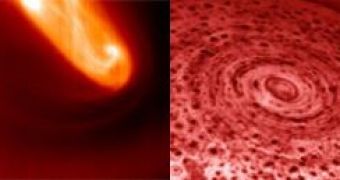The scientists working on the Cassini mission around Saturn were intrigued by the storm that exists at the planet's South Pole because they thought it resembles an Earth hurricane. But when Venus experts looked at the Cassini pictures, they saw something else. Instead of focusing on the overall structure of the Saturn's southern storm, they focused on the fact that the storm has plenty of spots.
They realized that these spots are in fact smaller storms that move in concert embedded inside the larger storm. The reason why they were intrigued by this is that the atmosphere near Venus' poles is also swirling in a weird way. Until now, astronomers have thought that Venus was unique: its polar storms are very unusual if you compare them to the storms on Earth in that they have two eyes.
The Saturn southern storm seems to be similar, only that it has a large number of eyes and not just two. Literally, hundreds of storm clouds encircle the pole, appearing as dark spots in this image (right). The left image was taken by the Ultraviolet/Visible/Near-Infrared spectrometer (VIRTIS) on board ESA's Venus Express on May 29, 2006, from a distance of about 64,000 kilometers from the planet. The right image was taken in October 2006 by the Visual Infrared Mapping Spectrometer (VIMS) on board NASA's Cassini.
These polar vortices are not hurricanes. "Hurricanes are caused by moist air rising into the atmosphere," explained Pierre Drossart, from the Observatoire de Paris, France. A polar vortex in contrast is created by an area of low air pressure that sits at the rotation pole of a planet. This causes air to spiral down from higher in the atmosphere. Even Earth has such polar vortexes, although not with multiple eyes or lobes like the ones on Venus.
The polar vortices on Venus are not understood very well and each time Venus Express passes within range, its instruments target a polar region. Scientists hope that by watching how they change, they can understand what causes them and that they can obtain clues about how the whole atmosphere circulates.
Now that they've realized that the polar vortex on Saturn is similar, they have a new lead. It now seems certain that these storms are purely atmospheric phenomena which don't depend on what exists at the surface of Venus. (Saturn might not even have a solid surface as it is a gas giant.)
By observing the storms in the infrared domain, the probes can see through the upper clouds which would otherwise block the view. "We will see down to more than 100 kilometres below the visible cloud tops," said Drossart. This allows scientists to determine the three-dimensional structure of each polar vortex and compare the vortices on Venus with those on Saturn. They should be able to get important clues about the various planetary atmospheres by studying the similarities and differences between the polar vortices.

 14 DAY TRIAL //
14 DAY TRIAL //